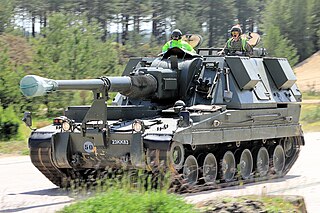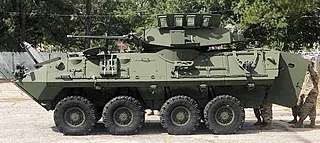
Artillery is a class of heavy military ranged weapons that launch munitions far beyond the range and power of infantry firearms. Early artillery development focused on the ability to breach defensive walls and fortifications during sieges, and led to heavy, fairly immobile siege engines. As technology improved, lighter, more mobile field artillery cannons developed for battlefield use. This development continues today; modern self-propelled artillery vehicles are highly mobile weapons of great versatility generally providing the largest share of an army's total firepower.

Self-propelled artillery is artillery equipped with its own propulsion system to move toward its firing position. Within the terminology are the self-propelled gun, self-propelled howitzer, self-propelled mortar, and rocket artillery. They are high mobility vehicles, usually based on continuous tracks carrying either a large field gun, howitzer, mortar, or some form of rocket/missile launcher. They are usually used for long-range indirect bombardment support on the battlefield.

The M109 is an American 155 mm turreted self-propelled howitzer, first introduced in the early 1960s to replace the M44. It has been upgraded a number of times, most recently to the M109A7. The M109 family is the most common Western indirect-fire support weapon of maneuver brigades of armored and mechanized infantry divisions.

The XM2001 Crusader was to be the United States Army's next-generation self-propelled howitzer (SPH), designed to improve the survivability, lethality, mobility, and effectiveness of the artillery as well as the overall force. It was initially scheduled for fielding by 2008. United Defense was the prime contractor; General Dynamics the major subcontractor. In early May 2002, Secretary of Defense Donald Rumsfeld canceled the US$11 billion program because he considered it neither mobile nor precise enough. The prototype SPH vehicle is on display at the cannon park at Fort Sill.

The Combat Vehicle 90 (CV90) is a family of Swedish tracked armoured combat vehicles designed by the Swedish Defence Materiel Administration (FMV), Hägglunds and Bofors during the mid-1980s to early 1990s, before entering service in Sweden in the mid-1990s. The CV90 platform design has continuously evolved from the Mk 0 to the current Mk IV with technological advances and changing battlefield requirements. The Swedish version of the main infantry fighting vehicle (IFV) is fitted with a turret from Bofors equipped with a 40 mm Bofors autocannon. Export versions are fitted with Hägglunds E-series turrets, armed with either a 30 mm Mk44 or a 35 mm Bushmaster autocannon.

The Bradley Fighting Vehicle (BFV) is a tracked armoured fighting vehicle platform of the United States developed by FMC Corporation and manufactured by BAE Systems Land & Armaments, formerly United Defense. The BFV is named after U.S. General Omar Bradley.

The AS-90, known officially as Gun Equipment 155 mm L131, is an armoured self-propelled artillery used by the British Army.

A mortar is usually a simple, lightweight, man-portable, muzzle-loaded weapon, consisting of a smooth-bore metal tube fixed to a base plate with a lightweight bipod mount and a sight. They launch explosive shells in high-arcing ballistic trajectories. Mortars are typically used as indirect fire weapons for close fire support with a variety of ammunition.

Future Combat Systems (FCS) was the United States Army's principal modernization program from 2003 to early 2009. Formally launched in 2003, FCS was envisioned to create new brigades equipped with new manned and unmanned vehicles linked by an unprecedented fast and flexible battlefield network. The U.S. Army claimed it was their "most ambitious and far-reaching modernization" program since World War II. Between 1995 and 2009, $32 billion was expended on programs such as this, "with little to show for it"..

The LAV-25 is a member of the LAV II family. It is an eight-wheeled amphibious armored reconnaissance vehicle built by General Dynamics Land Systems and used by the United States Marine Corps and the United States Army.

The M8 Armored Gun System (AGS), sometimes known as the Buford, is an American light tank that was intended to replace the M551 Sheridan and TOW missile-armed Humvees in the 82nd Airborne Division and 2nd Armored Cavalry Regiment of the U.S. Army respectively.
List of abbreviations, acronyms and initials related to military subjects such as modern armour, artillery, infantry, and weapons, along with their definitions.

The Manned Ground Vehicles (MGV) was a family of lighter and more transportable ground vehicles developed by BAE Systems and General Dynamics as part of the U.S. Army's Future Combat Systems (FCS) program. The MGV program was intended as a successor to the Stryker of the Interim Armored Vehicle program.

The Ground Combat Vehicle (GCV) was a program initiated by the United States Army in 2009, with the goal of developing a next-generation armored fighting vehicle. The first variant of the GCV to be developed would be an infantry fighting vehicle to replace the M2 Bradley.
FCS/BCT unmanned aerial vehicles was a collection of unmanned aerial vehicles developed under the jurisdiction of the Future Combat Systems (FCS) program until it was dissolved and succeeded by the BCT Modernization program.

The Artillery Gun Module is an air-portable 155 mm self-propelled howitzer designed by Krauss-Maffei Wegmann. It is based on technology used in the German Army Panzerhaubitze 2000 system, to provide more air portable self-propelled artillery, transportable by Airbus A400 aircraft.
The Armored Systems Modernization (ASM) was a U.S. Army combat vehicle procurement program canceled in 1992. The Army sought to develop a family of six armored vehicles based on two common chassis, one heavy and one medium, which would both share commonalities. Systems that the ASM sought to replace included the M1 Abrams main battle tank, M109 howitzer and M2 Bradley infantry fighting vehicle. The Army spun out several of the systems—Advanced Field Artillery System, Line-of-Sight Anti-Tank and the Armored Gun System—after canceling the program, but all of these programs were eventually canceled.

The Enigma is an 8×8 wheeled amphibious armored personnel carrier developed by Emirates Defense Technology in UAE. It was introduced at IDEX 2015.

The M1299 is an American prototype 155 mm self-propelled howitzer developed by BAE Systems in 2019 under the Extended Range Cannon Artillery (ERCA) program. It is based on the M109A7 howitzer, and was primarily designed for the purpose of improving the M109's effective range.
The XM1100 Scorpion, formerly known as the Intelligent Munitions System, was an anti-vehicle, smart ground munition developed by Textron Defense Systems as a safer alternative to traditional landmines. The Scorpion was originally a component of the Future Combat Systems program. It was a remotely controlled, integrated system of lethal and non-lethal munitions, ground sensors, and communication technology that could autonomously detect, track, and destroy light-wheeled to heavy-tracked vehicles.

















